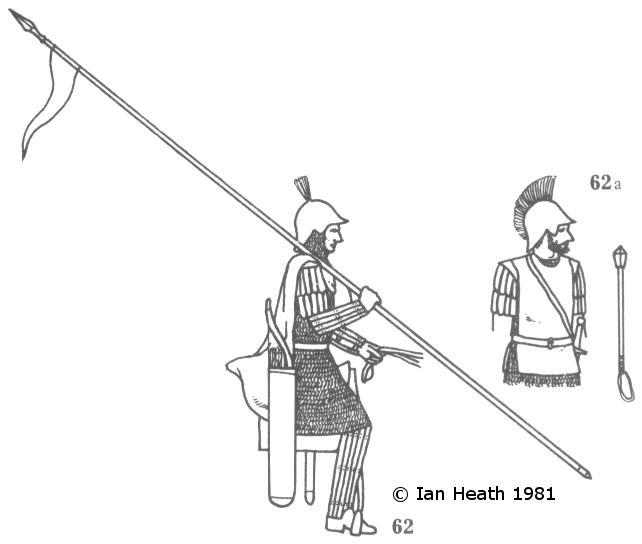HERACLIAN BYZANTINE HEAVY CAVALRYMAN
An extract from The Armies and Enemies of Imperial Romeby Phil Barker, illustrated by Ian Heath

62. HERACLIAN BYZANTINE HEAVY CAVALRYMAN

Cavalry development continued after Belisarius' campaigns, reaching its peak under the Emperor Heraclius, the last ruler to have the whole of the eastern Roman empire at his disposal and to have a fully regular army. The figure illustrated is based on descriptions in the tactical manual written by Heraclius' predecessor Mauricius. There are no contemporary representations in art, but items such as the distinctive helmet are taken from slightly later pictorial sources.
He wears an iron helmet and mail shirt, supplemented in the case of front rank men by iron splint protection for the fore arms and lower legs and a mail hood hooked up to his helmet. Other ranks might also have these if sufficient quantities were available, which they often were not. All ranks were armed with Kontos, now renamed Kontarion, bow and sword. These were often supplemented by lead-weighted throwing darts called "Marzobaboula", a corruption of the earlier Martiobarbuli, carried in a leather case on the front of the saddle. A small round shield was strapped to the upper left arm so as not to hinder archery. Although all ranks carried both Kontarion and bow, the 1st, 2nd and 5th ranks were primarily trained as lancers, the 3rd and 4th primarily as archers.
62a shows the larger crest identifying an officer and the Bardoukion or mace that was the officers additional side arm. It also shows the open sided surcoat sometimes worn.
Clothing was of linen in summer, dyed goatskin in winter. Gauntlets and boots were of yellowish leather. Red and blue were popular clothing colours, but at this time the cloak was usually of yellow-brown to aid in concealment. Helmet crests, pennons, and surcoats were dyed a regimental colour matching the primary colour of the shield and the standard, which for cavalry was a Bandon, the same as the earlier Roman vexillum. Bucellarii had similar tufts to helmet crests pointing up and out at the tips of their shoulders to indicate their former role as elite bodyguards.
Horse furniture included a well made saddle, which for the first time included stirrups, adopted from the Avars. Front rank and officers' horses had their head, neck and chest protected by iron or leather scale armour. Horses had tuft plumes in regimental colours at forehead, chin, and two each side of their rumps. Although modern tests have shown the value of the stirrup has been exaggerated, it does aid stability in riding over rough ground or striking downwards with a sword.
Although the later development of Byzantine cavalry is out of place here and is covered by Ian Heath's companion book Armies of the Dark Ages, it can be quickly said that it was later found preferable to have mixed units of archers and lancers rather than have all men double armed. This made it possible to give the lancers a much larger kite-shaped shield. The surcoat developed into an extra quilted protection, and later into something very like the medieval "coat of plates".
Re splint armoured legs and arms:
DBM Army lists Book 3 (1999) by Phil Barker & Richard Bodely Scott, 17. Maurikian Byzantine. 575AD - 650AD:
"Modern writers suggesting that cavalry were armoured "to the ankle" seem unaware that the same word in Greek is used for ankle, elbow and wrist. Both the latter seem more likely."